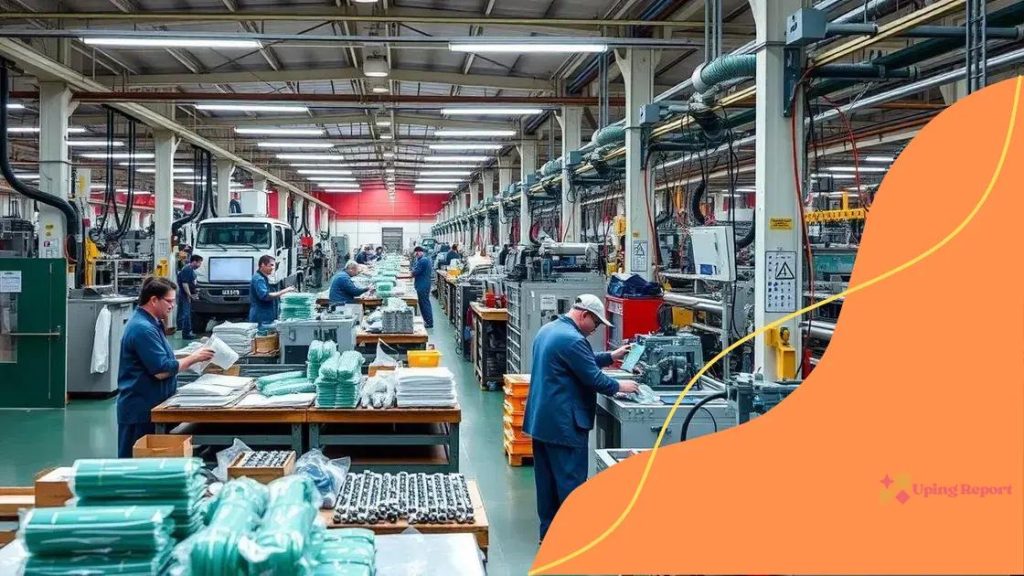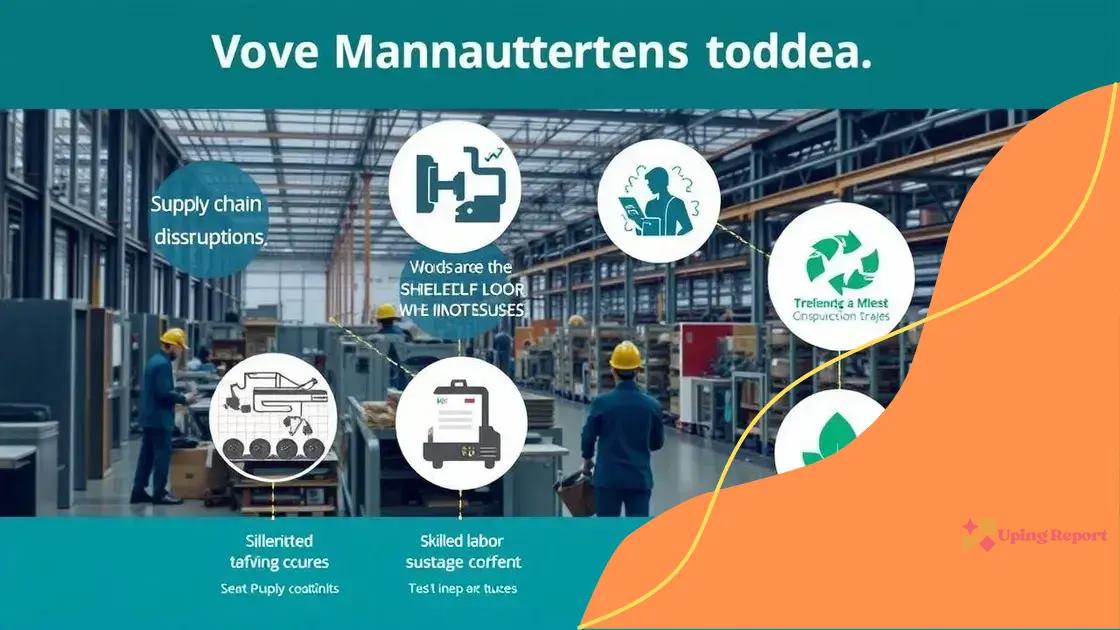US manufacturing sector growth: opportunities ahead

The US manufacturing sector is experiencing growth driven by increased automation, customization, and sustainability, while facing challenges like labor shortages and supply chain disruptions.
The notion of US manufacturing sector growth has been a hot topic lately as the industry evolves. Have you considered how these changes might impact local economies and job markets? In this article, we’ll delve into the factors behind this growth, the challenges manufacturers face, and what it all means for the future.
Current trends in US manufacturing
Current trends in US manufacturing show a fascinating shift as industries adapt to new technologies and market demands. The importance of staying innovative is clear. Manufacturers are embracing advancements that enable greater efficiency and responsiveness.
Adoption of Advanced Technologies
One of the most significant trends is the widespread adoption of advanced technologies like automation and artificial intelligence. These tools help streamline operations and reduce costs.
- Increased productivity through automation
- Use of AI for predictive maintenance
- Integration of IoT for real-time tracking
As manufacturers integrate these technologies, they can respond more effectively to changing consumer preferences. Additionally, a focus on sustainability is becoming paramount.
Sustainability in Manufacturing
Today’s consumers are increasingly concerned about the environmental impact of products. Thus, many manufacturers are implementing sustainable practices to reduce their carbon footprint. This shift not only benefits the planet, but it can also attract eco-conscious customers.
- Utilizing renewable energy sources
- Reducing waste through lean manufacturing
- Recycling materials and products
Moreover, workforce development is another critical trend. As the manufacturing landscape evolves, companies are prioritizing upskilling their employees to keep pace with industry changes.
Investing in educational programs ensures that workers possess the necessary skills required for high-tech manufacturing roles.
Key drivers behind sector growth
The growth of the US manufacturing sector can be attributed to several key drivers that shape the industry landscape. Understanding these drivers helps to reveal why this sector is experiencing a renaissance in recent years.
Technological Advancements
One of the primary factors contributing to growth is the rapid advancement of technology. New tools and systems allow manufacturers to enhance productivity and reduce operational costs. Automation plays a significant role in this transformation.
- Enhanced efficiency through robotics
- Data analytics for informed decision-making
- Integration of the Internet of Things (IoT) for connectivity
This integration of technology not only optimizes production but also helps manufacturers adapt to market demands quickly.
Global Supply Chain Management
Another essential driver is the effective management of global supply chains. As companies expand their reach, they demand more streamlined operations. Improved logistics and supply chain management can significantly boost operational efficiency.
- Real-time tracking of shipments
- Reduced lead times for product delivery
- Better risk management through diversified sources
Additionally, favorable government policies and incentives are fostering an environment where manufacturing can thrive. Tax incentives and funding for R&D initiatives provide much-needed support for innovation.
Moreover, the rising demand for customized products creates opportunities for manufacturers to tailor their offerings, making flexibility a vital element in their growth strategy.
Challenges faced by manufacturers today

Manufacturers today face a variety of challenges that impact their ability to grow and adapt in a fast-changing environment. Understanding these challenges is crucial for navigating the modern industrial landscape.
Supply Chain Disruptions
One major issue manufacturers encounter is supply chain disruptions. These interruptions can stem from various factors, including global events and shifts in demand. This uncertainty can lead to delays in production and increased costs.
- Late deliveries of raw materials
- Inconsistent pricing of components
- Inability to meet customer demand
In effect, these problems can strain relationships with customers and suppliers alike.
Labor Shortages
Another pressing challenge is the shortage of skilled labor. As the manufacturing landscape evolves, companies struggle to find workers with the necessary skills to operate advanced machinery and technology.
- High competition for qualified workers
- Need for ongoing training programs
- Attraction and retention strategies for new talent
This shortage not only affects productivity but can also hinder innovation and growth in the sector.
Additionally, the increasing need for sustainability puts pressure on manufacturers to implement environmentally friendly practices. Compliance with regulations can be resource-intensive.
As they strive for sustainability, manufacturers may also face the challenge of balancing costs with environmental responsibility. This requires careful planning and investment in new technologies.
Strategies for sustainable practices
Implementing sustainable practices is vital for manufacturers aiming to thrive in a competitive market. As customers increasingly demand eco-friendly products, companies must adapt to meet these expectations while also considering their environmental impact.
Energy Efficiency
One effective strategy is increasing energy efficiency throughout the manufacturing process. By adopting technologies that reduce energy consumption, manufacturers can lower costs and minimize their carbon footprint.
- Investing in energy-efficient machinery
- Utilizing smart systems to monitor energy use
- Implementing renewable energy sources like solar or wind
These changes not only support sustainability but also appeal to eco-conscious consumers.
Waste Reduction Techniques
Another important aspect is waste reduction. Manufacturers can adopt practices that minimize waste generation and maximize recycling efforts.
- Implementing lean manufacturing principles
- Encouraging recycling and reuse of materials
- Conducting regular waste audits to identify areas for improvement
By focusing on these techniques, companies can enhance their sustainability while optimizing resource use.
Moreover, supply chain management plays a critical role in sustainable practices. Collaborating with suppliers who prioritize environmental responsibility can strengthen a manufacturer’s sustainability goals.
Additionally, educating employees about sustainable practices can foster a culture that embraces environmental responsibility at all levels. This collective effort can lead to significant positive changes within the manufacturing environment.
Future outlook for US manufacturing
The future outlook for US manufacturing is promising, with several trends shaping its evolution. As technologies advance and global markets shift, American manufacturers have the opportunity to capitalize on new developments.
Increased Automation
One significant trend is the rise of automation. Manufacturers are increasingly adopting robots and automated systems to enhance production efficiency and reduce labor costs. This shift can lead to faster production rates and improved product quality.
- Robotics for repetitive tasks
- AI-driven analytics for process optimization
- Smart factories utilizing interconnected systems
As a result, companies can stay competitive and meet the demands of a growing market.
Focus on Customization
Another important aspect is the growing focus on customization. Today’s consumers seek personalized products tailored to their unique preferences. Manufacturers who can adapt their production processes to offer customized options will likely gain a competitive edge.
- Flexible manufacturing systems
- Advanced technologies for quick adjustments
- Customer feedback integration into product design
By prioritizing customization, manufacturers can foster stronger customer relationships.
Furthermore, sustainability will play a crucial role in shaping the future of US manufacturing. Companies that embrace eco-friendly practices will not only reduce their environmental impact but also attract more environmentally conscious consumers.
Investments in green technology and sustainable materials can help establish a positive brand image while contributing to a healthier planet.
In conclusion, the future of the **US manufacturing sector** looks bright. Companies are embracing innovation, from automation to sustainable practices. By adopting advanced technologies and focusing on customer preferences, manufacturers can stay competitive. However, they must also address challenges like skilled labor shortages and supply chain disruptions. With a commitment to sustainability and flexibility, manufacturers can create a positive impact on both the market and the environment.\n\n\n
\n
\n
FAQ – Frequently Asked Questions about US Manufacturing Growth
What are the main trends driving growth in US manufacturing?
Key trends include increased automation, a focus on customization, and a commitment to sustainable practices.
How is automation impacting productivity in manufacturing?
Automation enhances productivity by allowing machines to perform repetitive tasks, freeing human workers for more complex roles.
Why is sustainability important for manufacturers?
Sustainability is crucial as consumers prefer eco-friendly products, and manufacturers that adopt green practices can improve their brand image and attract more customers.
What challenges do manufacturers face today?
Manufacturers face challenges like skilled labor shortages, supply chain disruptions, and the need to keep up with rapid technological changes.
